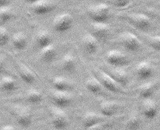Endometrial Epithelial Cells (EEC)
Uterus, Endometrium

Endometrium is a layer of the inner wall of a mammal. The endometrium is covered with mucous membrane, which is composed of the mucosa epithelium and the underlying layer. The lower part of the mucosal epithelium is called the functional layer, which forms the uterine gland and responds to the estrogen. The lower layer of the functional layer is called the basal layer, which is rich in blood vessels.
Endometrial epithelial cells (EEC) are in a single lamellar arrangement, the shape of tadpoles, clear cell outline, the nucleus is large and obvious. There are small filamentous connections between cells, and often around a small group of cells. The cells were positive for cytokeratin, vimentin positive cells rarely. Endometrial epithelial cells provide an ideal and valuable experimental model for the study of the pathogenesis of uterine diseases or therapeutic drug screening.
Organism species: Homo sapiens (Human)
- Cell CSI035Hu01 Primary Human Endometrial Epithelial Cells (EEC) In Stock
- Customized Service n/a Extract of Endometrial Epithelial Cells (EEC) Total Protein/DNA/RNA Extract Customized Service Offer
- Customized Service n/a Medium for Endometrial Epithelial Cells (EEC) (If Necessary) Cell Culture Medium Customized Service Offer
Organism species: Mus musculus (Mouse)
- Cell CSI035Mu01 Primary Mouse Endometrial Epithelial Cells (EEC) In Stock
- Customized Service n/a Extract of Endometrial Epithelial Cells (EEC) Total Protein/DNA/RNA Extract Customized Service Offer
- Customized Service n/a Medium for Endometrial Epithelial Cells (EEC) (If Necessary) Cell Culture Medium Customized Service Offer
Organism species: Rattus norvegicus (Rat)
- Cell CSI035Ra01 Primary Rat Endometrial Epithelial Cells (EEC) In Stock
- Customized Service n/a Extract of Endometrial Epithelial Cells (EEC) Total Protein/DNA/RNA Extract Customized Service Offer
- Medium MSI035Ra11 Medium for Rat Endometrial Epithelial Cells (EEC) In Stock
Organism species: Oryctolagus cuniculus (Rabbit)
- Cell CSI035Rb01 Primary Rabbit Endometrial Epithelial Cells (EEC) In Stock
- Customized Service n/a Extract of Endometrial Epithelial Cells (EEC) Total Protein/DNA/RNA Extract Customized Service Offer
- Medium MSI035Rb11 Medium for Rabbit Endometrial Epithelial Cells (EEC) In Stock
Organism species: Felis catus; Feline (Cat)
- Cell CSI035Fe01 Primary Feline Endometrial Epithelial Cells (EEC) In Stock
- Customized Service n/a Extract of Endometrial Epithelial Cells (EEC) Total Protein/DNA/RNA Extract Customized Service Offer
- Medium MSI035Fe11 Medium for Feline Endometrial Epithelial Cells (EEC) In Stock
Organism species: Canis familiaris; Canine (Dog)
- Cell CSI035Ca01 Primary Canine Endometrial Epithelial Cells (EEC) In Stock
- Customized Service n/a Extract of Endometrial Epithelial Cells (EEC) Total Protein/DNA/RNA Extract Customized Service Offer
- Medium MSI035Ca11 Medium for Canine Endometrial Epithelial Cells (EEC) In Stock
Organism species: Capra hircus; Caprine (Goat)
- Cell CSI035Cp01 Primary Caprine Endometrial Epithelial Cells (EEC) In Stock
- Customized Service n/a Extract of Endometrial Epithelial Cells (EEC) Total Protein/DNA/RNA Extract Customized Service Offer
- Medium MSI035Cp11 Medium for Caprine Endometrial Epithelial Cells (EEC) In Stock


